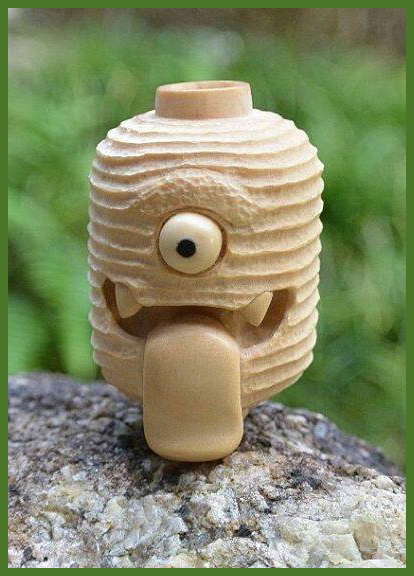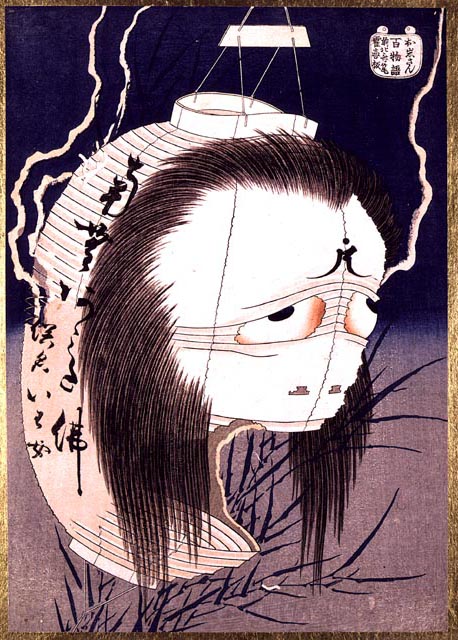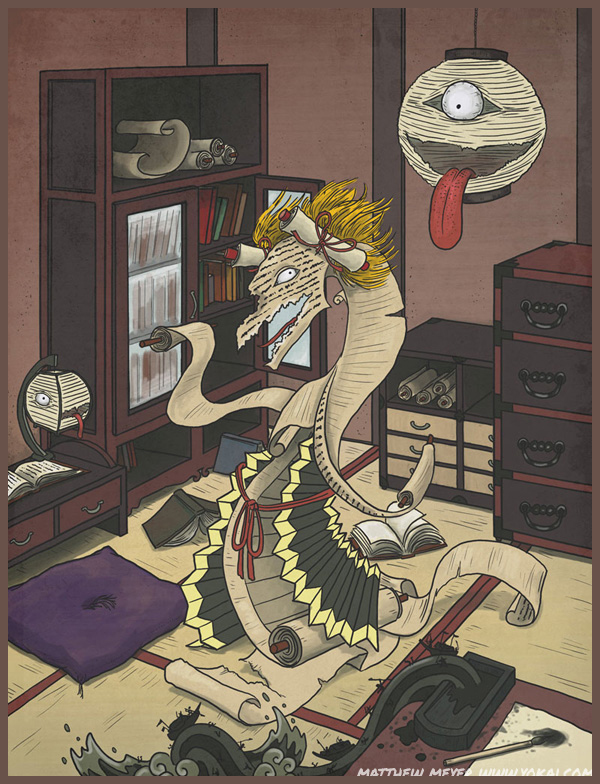. Tengupedia - ABC list - R till Z .
:::::::::::::::::::::::::::::::::::::::::::::::::::::::::::::::::::::::::::::::::::::::::::::::::::::::::::::::::::::::::::::::::::::::::::::::::::::::::::::::::::::::::::::::::::
Tengupedia - 天狗ペディア - Tengu ABC-List
Tengu 天狗 "heavenly dog" - "celestial dog"
This first part of the list includes keyword from A to P.
- continued here :
. Tengupedia - ABC list - from R to Z - .
. Tengu 天狗 Introduction in the Darumapedia .
Tengu are supernatural creatures found in Japanese folklore, art, theater, and literature. They are one of the best known Yokai妖怪 and are sometimes worshiped as 神 Shinto deities.

- Tengu mask from my collection -
. The most important Tengu of Japan .
四十八天狗 48 Tengu of Japan
日本三大天狗 three most important Tengu
八天狗 eight great Tengu of Japan
. Yama no Kami 山の神 God of the Mountain and Tengu .
:::::::::::::::::::::::::::::::::::::::::::::::::::::::::::::::::::::::::::::::::::::::::::::::::::::::::::::::::::::::::::::::::::::::::::::::::::::::::::::::::::::::::::::::::::
***** . Ajari 阿闍梨坊 Ajari-Bo Tengu 肥後阿闍梨 Higo Ajari Kōen 皇円 Saint Koen .
***** . Akagisan no Sugi no Bo 赤木山の杉の坊 the Monk of the Cedar Tree .
- from Mount Akagiyama 赤城山 Gunma (1,828 m)
. Akibagongen 秋葉権現 Akiba Gongen .
Akiba sanshakuboo 秋葉三尺坊 Akiba Sanjakubo - priest 周国 Kanekuni
吉野皆杉 小桜坊 Yoshino Minasugi Kozakura-Bo / 南無秋葉大権現 Namu Akiba Daigongen
***** . Amanozako 天逆毎(あまのざこ)Tengu Goddess / Metengu 雌天狗 female Tengu .
. amatsu oomi kitsune, amatsu kitsune アマツオオミキツネ Honorable Tengu .
. amefuri Tengu, ame-furi 雨ふり天狗 Tengu in the Rain .
- Story by Mizuki Shigeru
***** . Ashitateboo 足立坊 / アシタテボウ Ashitatebo, Ashitate-Bo (Ashidate) . - Niigata
Atago-yama, Atagoyama 愛宕山 Mount Atago, Kyoto, see Tarobo-Tengu
. Beni-Tengutake, benitengutake ベニテングタケ(紅天狗茸) "Red Tengu Mushroom".
Amanita muscaria (- see Tengutake - Tengudake)
. Beshimi - Noh Drama 能 "The world of Noh" - and its demon masks .
kishin 鬼神 demon deities - 飛出 Tobide portraying demons or savages, and
癋見 / 閉歯見 Beshimi portraying goblins such as Tengu.
. beer 天狗 ビール Tengu Beer brands - photos .
- - - . Books about Tengu 天狗の本 .
***** . Buzenboo, Buzenbō 豊前坊 Buzenbo, Buzen-Bo Tengu .
彦山豊前坊 - Hikozan Buzenbo, Fukuoka
. Chiba and its Tengu legends 千葉県と天狗伝説 .
- Chiba no kotengu 千葉の小天狗 The Small Tengu from Chiba
- 嶺岡浅間の天狗面 Mineoka Asama Tengu Masks
- 高宕山と天狗面 Takagoyama and the Tengu Masks / 観音堂の天狗面
. Chichibu 秩父の天狗さま The Tengu from Chichibu .
In Chichibu, the Tengu is seen as a mountain deity, Tengu-Shin 天狗神 Tengu-Kami, Tengu God.
***** . Chikugoboo, Chikugobō 高良山筑後坊 - Chikugobo, Korazan . - Fukuoka, Korasan
. chokinbako 貯金箱 piggy bank .
choochin 提灯 / 提燈 Chochin lanterns with Tengu
. . . CLICK here for Photos !
. Curry - Takaosan Tengu Curry 高尾山 天狗 カレー .
***** . Dantokuboo 檀特坊 / 壇特坊 Dantokubo, Dantoku-Bo . Osaka
河内国河上哮峯 Kawachi no Kuni, Takerugamine, 田原村 Tawara, Iwafune Jinja 磐船神社
. Dairoku Ten Maoo 第六天魔王 Dairoku Ten Mao .
- supposed to be a Tengu
. dai tengu, daitengu 大天狗 great Tengu, big Tengu, major Tengu .
. Daruma and Tengu 天狗とだるま .
- Little Daruma & Little Tengu だるまちゃんとてんぐちゃん book by Satoshi Kako
***** . Dooryoo Daigongen, Dōryō 道了大権現 Doryo Daigongen
妙覚道了大権現 Myokaku Doryo Daigongen
- Dooryoo Satta 道了薩埵 Doriyo Bosatsu at 明星ヶ岳 Mount Myojogadake, Hakone
. dorei どれい / 土鈴 clay bells 天狗 土鈴 . *
. ema 天狗絵馬 votive tablets with Tengu .
***** . Enkai 圓海 / 円海 Hinamaru Enkai of Mount Hagurosan 羽黒山 .
- Tengu teaches martial arts to Tsukahara Bokuden 塚原卜伝 (1489 - 1571)
***** . Enkooboo 円光坊, Enkobo, Enko-Bo " 水天狗円光坊 "Water Tengu" .
at Mount Hagurosan - Yamagata, one of the 四十八天狗 48 Tengu of Japan
Haguro san mizu tengu 羽黒山の水天狗円光坊
***** . Etchu Tateyama Shijooboo 越中立山縄乗坊 Shijo-Bo, Shijobo .
Joosuiboo ジョウスイボウ Josui-Bo
.......................................................................
. - - - - - Folktales with Tengu 天狗の絵本、and picture books .
Kobu-tori Jiisan 瘤取り爺さん The Old Man's Lump Removed
Takara no geta 宝の下駄 Precious Geta
Tengu no ha-uchiwa 天狗の羽団扇 feather fan of a Tengu
Tengu no hiaburi, hi-aburi 天狗の火あぶり Tengu in fire
Tengu no Hyōtan 天狗の瓢箪 Hyotan, The Tengu's Gourd
Tengu no Kakuremino 天狗の隠れみの The Tengu's Magic Cloak
Tengu no koma 天狗のこま
The Tengu, and the Woodcutter 山仕事
- Tengu まんが日本昔ばなし Manga Nippon Mukashibanashi
. tojikomerareta Tengu とじこめられた天狗 a Tengu in confinement . - Toyama
.......................................................................
***** . Fuji Tengu 富士天狗(富士太郎)Fujitaro Tengu from Mount Fuji .
- Daraniboo, Daranibō 陀羅尼坊 Darani-Bo, Daranibo
This is the most important of all the Tengu goblins from Japan. In Gotenba town, he is called "Fuji Taro".
. Fukuo Jinja 福王神社 Fukuo Shrine, Mie .
- 天狗坂 Tengusaka slope, Tengu sugi 天狗杉 Tengu cedar
- Tengu Oharai, O-harai 天狗おはらい Tengu Purification Ritual / 天狗のお払い at Setsubun
- Tengu no Odori Koba 天狗の踊り小場 Small place for the Tengu to dance
- Tengu Soba 天狗そば Tengu Soba Buckwheat noodles
. Fukushima 福島県 Tengu Legends .
- - - Tengu tsubute-ishi 天狗礫石 Tengu throwing gravel stones / 天狗岩 Tenguiwa boulder i
- - - Tengu no warapuchi-ishi 天狗の藁ブチ石
- - - Hime no Gozen Yama 姫の御前山 /姫御前山 Mount Himegozen where Tengu live
- - - Takegarayama 竹柄山 / 竹がら山 Mount Takegarayama where Tengu live
- - - Tengu-doori 天狗通り Tengu passing
- - - Tengu-Yama 天狗山 Mount Tenguyama
- - - Tengu no Mori 天狗の森 Forest of the Tengu
. Fuujin 風神としての天狗 Tengu as God of the Wind .
. eggplants 天狗ナス Tengu nasu - photos .
. Garuda Bird, Karura 迦楼羅 King Garuda, Karura O 迦楼羅王.
. geta 下駄 wooden clogs of a Tengu .
. Gobanishiyama 碁盤石山 A Mountain with a Tengu Legend . - Aichi
. guhin kuhin gubin 狗賓 / グヒン Guhin Tengu Yokai monster .
. hachidaitengu 八大天狗 eight great Tengu .
. Hakone Miyaginomura no Tengu 箱根宮城野村の天狗 . - from 1749
hakuroo tengu 白狼(はくろう)天狗 / 白狼天狗 Hakuro Tengu, "white wolf Tengu"
another name for 木の葉天狗 Konoha Tengu
. Hakusanboo 白山坊 Hakusan-Bo, Hakusanbo .
Taichoo, Taichō 泰澄上人 Saint Taicho Shonin / Taicho-Daishi 泰澄大師 (682 ?683 - 767)
Etsu no Daitoku 越の大徳 - Great Man of Virtue from Etsu
Unpen Shoonin 雲遍上人 Saint Unpen Shonin
Shiramine Daisoojo 白峰大僧正 Shiramine Daisojo
and
Hakusan-Bo 白山坊 - a white fox Yokai, Mizuki Shigeru
. hanadaka tengu 鼻高天狗 long-nosed tengu .
hana ga takai 鼻が高い the long nose of a Tengu
. hanafuda 天狗花札 Tengu "Flower Trump" card game .
- issued by 任天堂 Nintendo in 1889
. hana tengu 鼻天狗 Hana-Tengu, "Nose-Tengu" .
***** . Hanzooboo, Hanzōbō 半僧坊 Hanzo-Bo, Hanzobo .
- Shizuoka, 遠州奥山半僧坊 Enshu Okuyama Hanzo-Bo / 方広寺 Hoko-Ji with his grave
- Kanagawa, Kamakura, 建長寺 Kencho-Ji - protector of fires
. 榛名天狗 Haruna Tengu / 満行権現 Mangyo Gongen . - Gunma
. ha uchiwa, ha-uchiwa 天狗の羽団扇 "feather fan" of a Tengu .
Der blattförmige Fächer vom Tengu
- and
hemp 麻 and shuro 棕櫚団扇 Shuro hemp-palm
***** . Hayatoboo 隼人坊 Hayato-Bo, Hayatobo from 古峯ヶ原 Kobugahara . - Gunma - 古峯ヶ原
. Hikawa Jinja 氷川神社 Akasaka 赤坂 Tokyo .
Parade of a Tengu draped in orange.
. Hirata Atsutane 平田篤胤 (1776 - 1843) .
- When Tengu Talk: Hirata Atsutane's Ethnography of the Other World
- - - - - . History of the Tengu in Japan .
. Hokusai Manga 北斎漫画 Hokusai Sketches . - 森羅万象 Shinra Bansho
. Hooinboo, Tsukuba-hōin, 筑波法印坊 Tsukuba Hoin-Bo of 日立 Hitachi Province .
Ibaraki, Mount Tsukubasan 筑波山 - Priest Tokuitsu (徳一) (781? - 842?)
***** . Hookiboo, Hōkibō 伯耆坊 Hoki-Bo, Hokibo .
- From Mount Hoki Daisen, Tottori / 伯耆大山清光坊 - see Seikobo
***** . Hookiboo, Hōkibō 石槌山 法起坊 Hoki-Bo - .
- From Mount Ishizuchisan 石槌山 - Ehime
***** . Hooseiboo 比叡山法性坊 Hosei-Bo, Hoseibo, Hieizan .
妙義大権現 Myogi Daigongen, coming from Kyoto, Hieizan in 940.
***** . Ibukiyama Tengu 伊吹山の天狗 - 三朱沙門飛行上人 .
- and 三修禅師 Zen Priest Sanshu Zenji
. ichimon tengubata . hata 一文天狗旗 flag with tengu goblin .
Miyagi
. Iga no Ao-Tengu 伊賀の青天狗 the Green Tengu from Iga .
. illustrations 天狗 イラスト - photos .
. Imakumasan 今熊山 and 今熊神社 Imakuma Jinja . - Tama, Tokyo
. inoshishi 烏天狗騎猪 Karasu Tengu riding on a wild boar .
. Inazuma Taizoo 稲妻大蔵 Inazuma Taizo Sumo wrestler .
and wrestler 鬼ヶ岳 Onigadake,
. iso tengu 磯天狗 Isotengu, Iso-Tengu, "Seashore Tengu", a Sea Yokai .
. Issa 小林一茶 Kobayashi Issa and Tengu Haiku .
Itogoromo Tengu Haikai 糸衣天狗俳諧 in 6 volumes in 1815. (Itogoromo Tengu Baikai (?))
by Shinto Ga / illustrated by Nakamura Utaemon (the 3rd.)
- photos on facebook -
- reference -
. Iyogatake 伊予ケ岳 Mount Iyogatake Tengu . - Chiba
. Izuna Daigongen 飯縄大権現 Iizuna Daigongen .
- and Saburo Tengu
Ishizuchisan 石鎚山 "Stone Hammer Mountain", Ehime
Tengudake 天狗岳 Mount Tengudake 1982m - center of the Ishizuchisan Tengu cult
- see above, Hoki-Bo
***** . Jirooboo, Jirōbō 次郎坊 / 二郎坊 Jirobo Tengu .
- 比良の次郎坊 Hira no Jirobo / 比良治郎坊
***** . Kabasan 加波山石切大神 Kabasan Iwakiri Okami .
Iwakiri Daigongen 岩切大権現 / Iwakiri Okami Tengu 岩切大神天狗
. kamikakushi, kami-kakushi 天狗と神かくし / カミカクシ "spirited away" .
. kanban to tengu 天狗と看板 shop signs with Tengu .
- and hanakaruta 花かるた / 鼻かるた
. Karasutengu, Karasu Tengu 烏天狗、からす天狗 / カラステング
Crow Tengu, Bird Tengu /// kotengu 小天狗 minor Tengu, crow-like goblin .
-- Crow Tengu Riding Boar (Karasu Tengu 烏天狗騎猪)
. Kasagizan Daisoojoo 笠置大僧正 Kasagizan Daisojo Tengu .
. Kashozan 迦葉山 a Tengu mountain .
群馬県 沼田市上発知町445番地 Gunma, Numata
. kawara 瓦 roof tiles with Tengu .
..... - reference 補陀山圓通寺 : 愛知県名古屋市熱田区 -
. kawatengu, kawa tengu 川天狗 river Tengu, a kind of Kappa .
. Kayagatake 茅ヶ岳 Mount Kayagatake .
- and 金が岳 Mount Kanagatake Tengu legend, Yamanashi
. kendama けん玉 cup and ball with Tengu .
. kendoo 剣道 Kendo - 天狗 Tengu and The Way of the Sword .
- 剣道独稽古 - 山本晴幸 Kendo Hitori Keiko - Practising Kendo Fencing by yourself
- Japanese Armour - yoroi 鎧 and kabuto 兜 with Tengu
- Tengu no Ken 天狗の剣 The Sword of the Tengu - book by Fujimoto Hitomi 藤本ひとみ
. Kidoomaru, Kidōmaru 鬼童丸 Kidomaru .
Kidomaru learning magic from the tengu / Utagawa Kuniyoshi 歌川国芳
. Kinai Shichi Tengu 畿内七天狗 seven Tengu of the Kinai district .
鞍馬の僧正坊 - Sojo-Bo from Kurama
愛宕山の太郎坊 - Taro-Bo from Mount Atago
笠置山の大僧正 - Daisojo from Kasagizan
熊野大峯の菊犬坊 - Kikujo-Bo from Kumano Omine
吉野の皆杉小桜坊 - Kozakura-Bo from Yoshino Minasugi
那智滝本の前鬼坊 - Zenki-Bo from Nachi
高野山の高林坊 - Korin-Bo from Koyasan
- Their boss is 天狗魔王尊 Tengu Mao Son
. Knutsen, Roald Knutsen - Book .
Tengu -The Shamanic and Esoteric Origins of the Japanese Martial Arts
Kobi no Tengusan 古井の天狗山 - largest Tengu in Japan, 12 meter statue
岐阜県美濃加茂市森山町3-5-57 / 3-5-57, Moriyama-cho, Minokamo C. Gifu
- source : kikuko-nagoya.com/html/kobi-no-tengusan... -
. kobutori jiisan こぶとりじいさん / 瘤取り爺さん "The Old Man's Lump Removed" .
- folktale
source : mytwoyenworth.blogspot.jp
. kokeshi こけしの天狗 / 天狗こけし wooden dolls of Tengu . *
. koma, Tengu koma 天狗独楽 spinning top with a Tengu . - Saitama
- - - - - . koma 独楽 more spinning tops with Tengu .
Konjaku Monogatari 今昔物語 "Tales of Times Now Past"
- late Heian period tales of many demons, monsters and Tengu - setsuwa 説話 religious teaching stories *
. konoha tengu, koppa tengu 木の葉天狗 / 木葉天狗 "foilage Tengu" .
a kind of karasu tengu / sakaidori 境鳥(さかいどり)
***** . Kongooboo 象頭山金剛坊 Kongo-Bo, Kongobo . - from Zōzusan 象頭山 Zozusan "elephant head mountain", Konpira Shikoku
- and Shukaiboo 趣海坊 Shukai-Bo (海趣坊 Kaishu-Bo).
***** . Konkooboo 金光坊 Konko-Bo, Mount Hagurosan - Yamagata .
- maybe identical to Sankooboo 三光坊 Sanko-Bo
. Konoyama no Aka-Tengu 神野山の赤天狗 the Red Tengu from Konoyama .
. Konpira mairi 金比羅参り pilgrimage to Mount Konpirasan Shikoku .
Konpira pilgrims carrying a tengu mask on their rucksack wooden box (oizuri)
***** . Konpiraboo 黒眷属 金比羅坊 Kurokenzoku Konpirabo .
Shikoku, Konpirasan
. Kookokuji 興国寺 Kokoku-Ji - Wakayama . - large Tengu maks
***** . Kootenboo, Kōtenbō 高天坊 Kotenbo of 葛城 Katsuragi .
***** . Koorinboo 高林坊 Korin-Bo, Korinbo .
at Mount Koyasan, related to Kukai.
And Myoo-on boo 妙音坊 Myoon-Bo, Myoonbo at Koyasan 高野山弁天岳 Mount Bentendake
***** . Koorinboo 宰府高垣高林坊 / 宰府高垣高森坊 Korin-Bo - Fukuoka .
and Miyamoto Musashi Slashing a Tengu
Kooshinzan 庚申山 Koshinzan - 猿田彦神社・庚申山 ― 天狗を探して
- reference source : akanekopn.web.fc2.com/soran -
kotengu 小天狗 small Tengu, minor Tengu, servants of the Daitengu. see Karasu Tengu
. Kurama Tengu 鞍馬天狗 - Kyoto.
Goho Mao Son 護法魔王尊, the great King of the conquerors of evil and the spirit of the earth, looks almost like a Tengu himself. 僧正坊 Sojobo
. Lafcadio Hearn, Koizumi Yakumo 小泉八雲 . - (1850-1904) (Koizumi Yagumo)
In Ghostly Japan : Chapter 14 : Story of A Tengu
. Legends 天狗と伝説 Tengu legends "Long-nosed Goblin" .
***** . Magoemon from Egusa 江草孫右衛門 . - Tengu from Yamanashi
. Manga and Tengu 漫画 /マンガと天狗 .
- - - - - . Manga Nippon Mukashibanashi まんが日本昔ばなし folk tales about Tengu .
- they have a long list of Tengu tales
. Mao 天狗魔王尊 Tengu Mao-Son .
..... Gohoo Maoo Son 護法魔王尊 Goho Mao Son
Martial arts and Tengu (WI)
. matches 天狗 マッチ to light a fire - photos .
. matsu Tengu matsu 天狗松 / 天狗と松 Legends about the Tengu pine .
. Tengu matsuri 天狗祭り Tengu festivals .
. men - Tengu no men 天狗の面 mask of a Tengu / 天狗面 Tengu Men .
. metengu, me tengu 女天狗 female Tengu, Amanozako .
長野・修那羅峠の女性天狗 - female Tengu, Nagano, Shunara Pass
東京 高尾山の天狗は女天狗? - female Tengu at Takao san
. miira, karasu tengu no miira 烏天狗のミイラ mummy of a Karasu Tengu .
. mikuji 天狗のみくじ Tengu no mikuji - sacred lot .
. Mingei 民芸と天狗 folk art motives with the Tengu Goblin .
. dorei どれい / 土鈴 clay bells .
. ema 絵馬 votive tablets .
. hariko 張子 papermachee dolls .
. Kappa 河童 the Water Goblin .
. kokeshi こけし wooden dolls .
. maneki neko, manekineko 招き猫 beckoning cat .
. tako 凧 kites .
. tsuchi ningyoo 土人形 tsuchiningyo clay dolls .
. ukiyo-e 浮世絵 "pictures of the floating world" .
. Mirokuji 弥勒寺 Miroku-Ji . Gunma Kashozan 迦葉山弥勒寺
. Miyamoto Musashi 宮本武蔵 (1584 - 1645) .
宮本無三四 Miyamoto 無三四 Musashi Slashing a Tengu
. Miyukiji 御幸寺 Miyuki-Ji .
Ehime, Matsuyama-shi, Miyuki, 1 Chome−442−1 - - - with Haiku by Masaoka Shiki
mizutengu, mizu tengu, ?suitengu 水天狗 "Water Tengu", see kawatengu
. mochi 餅 ritual rice cakes .
- O-Tengu Sama no Obi お天狗様の帯 Belt of the Tengu.
- Tengu no Sawa Mochi 天狗のサワ餅.
- Tengu Sama no Omigoku 天狗様のオミゴク Offering for the Tengu.
. mukai tengu ema 迎い天狗絵馬 Tengu facing each other .
- and many ema votive tablets
***** . Myoogiboo, Myōgibō 上野 妙義坊 Myogi-Bo, Myogibo of Ueno . - Gunma
***** . Myoogizan Nikkooboo 妙義山日光坊 - Nikkobo, Myogisan . - Gunma
***** . Myoo-on boo 妙音坊 Myoon-Bo, Myoonbo at Mount Koyasan .
***** . Nagakiyo 長清法印天狗 Nagakiyo Hoin Tengu .
- 妙義山中之岳大天狗 Mayoke Myogi Nakanotake Dai Tengu
***** . Nichiraboo 日羅坊 Nichira-Bo, Nichirabo .
At 愛宕山 Mount Atago
. Nikko 日光 Many Tengu from Nikko, Gunma .
日光山東光坊 - Tengu Tokobo / 妙義山日光坊 Tengu Nikkobo
古峯ヶ原隼人坊 Hayato-Bo from Kobugahara
. ningyoo 天狗人形 dolls and figures of Tengu .
***** . Nokkinboo 破風山のノッキン坊天狗 Nokkinbo Tengu, Nokkin-Bo . Chichibu Happusan
- ニョッキンボウ Nyokkin-Bo
. o-mamori, omamori 天狗 お守り amulets with a Tengu . *
. Otsuna Kotohira Jinja 大綱金刀比羅神社 Yokohama .
- with a 大天狗の像 - Statue of the Great Tengu
- - - - - Origins of Tengu (MS)
. pants 天狗 パンツ for the real man ! - photos .
- - - - - - pinterest photo collection of 天狗 -
. Plants with Tengu - 植物と天狗 .
Beni-Tengu-Dake, benitengudake ベニテングタケ(紅天狗茸) "Red Tengu Mushroom"
Tengu Shide テングシデ Tengu Hornbeam (Forest in Hiroshima)
yatsude やつで (天狗のはうちわ) Tengu no ha-uchiwa
Fatsia japonica, Japanese Fatsia "eight arms, eight hands"
. pokkuri tengu ぽっくり天狗 Tengu for a healthy long life and sudden death .
Protective spirits and deities - (WI)
the Shasekishū, 沙石集 a book of Buddhist parables from the Kamakura period, makes a point of distinguishing between good and bad Tengu.
priests who turned into Tengu (ta)
玄隈 Genbo - 、慈恵 Jiei Daishi (Hieizan), 尊雲 Sonun
.......................................................................
. proverbs and sayings with "Tengu" ことわざ kotowaza .
koboozu hitori tengu hachinin 小坊主ひとり天狗八人
. Tengu-daoshi, Tengu daoshi, tengudaoshi 天狗倒し "Tengu knocking down trees" .
- Tengu bayashi 天狗囃子 / Tengu taiko 天狗太鼓 / Tengu warai 天狗笑い
Tengu kakushi 天狗隠し
Tengu no miakashi, me-akashi 天狗の御燈 (roojinbi 老人火, 怪火 ghost fire)
Tengu ni naru 天狗になる / hana ga takaku naru 鼻が高くなる
Tengu ni karakasa torareta yoo 天狗に唐傘取られたよう
Tengu no kinobori 天狗の木登り
Tengu no koogeki 天狗の攻撃
Tengu no nagesan 天狗の投げ算
Tengu sarai 天狗攫い (same as Tengu kakushi)
Tengu tsubute 天狗つぶて / 天狗礫
Tengu no yusaburi 天狗の揺さぶり
tsuri Tengu ni kikimimi nashi 釣り天狗に聞き耳なし
- to be updated
.............................................................................................................................................

..............................................................................................................................................
- continue here :
. Tengupedia - 天狗ペディア - list - from R to Z - .
:::::::::::::::::::::::::::::::::::::::::::::::::::::::::::::::::::::::::::::::::::::::::::::::::::::::::::::::::::::::::::::::::::::::::::::::::::::::::::::::::::::::::::::::::::
. - - - Join my Tengupedia friends on facebook ! - - - .
The latest additions are on facebook !
:::::::::::::::::::::::::::::::::::::::::::::::::::::::::::::::::::::::::::::::::::::::::::::::::::::::::::::::::::::::::::::::::::::::::::::::::::::::::::::::::::::::::::::::::::
- - - reference : Mark Schumacher (MS) - - - The Best Information !
- - - reference : wikipedia (WI) - - -
天狗の総合研究サイト
- reference source : takaosan.info/tengu -
Legends of Japan
by Hiroshi Naito (Author), Masahiko Nishino (Illustrator)
- at amazon com
Tengu. Darstellungen im Nihon shoki und im Konjaku monogatari shū
Michael Jürges
Inhalt und Leseprobe aus 61 Seiten ist hier
- reference source : grin.com/de/e-book/289145... -
:::::::::::::::::::::::::::::::::::::::::::::::::::::::::::::::::::::::::::::::::::::::::::::::::::::::::::::::::::::::::::::::::::::::::::::::::::::::::::::::::::::::::::::::::::
. yookai, yōkai 妖怪 Yokai monsters - Introduction .
. Tengu 天狗と伝説 Tengu legends "Long-nosed Goblin" .
. Legends and Tales from Japan 伝説 - Introduction .
. Mingei 民芸 Regional Folk Art from Japan .
- #tengupedialist #tengu #tengupedia #tenguabc -
:::::::::::::::::::::::::::::::::::::::::::::::::::::::::::::::::::::::::::::::::::::::::::::::::::::::::::::::::::::::::::::::::::::::::::::::::::::::::::::::::::::::::::::::::::
[ . BACK to DARUMA MUSEUM TOP . ]
[ . BACK to WORLDKIGO . TOP . ]
:::::::::::::::::::::::::::::::::::::::::::::::::::::::::::::::::::::::::::::::::::::::::::::::::::::::::::::::::::::::::::::::::::::::::::::::::::::::::::::::::::::::::::::::::::



























